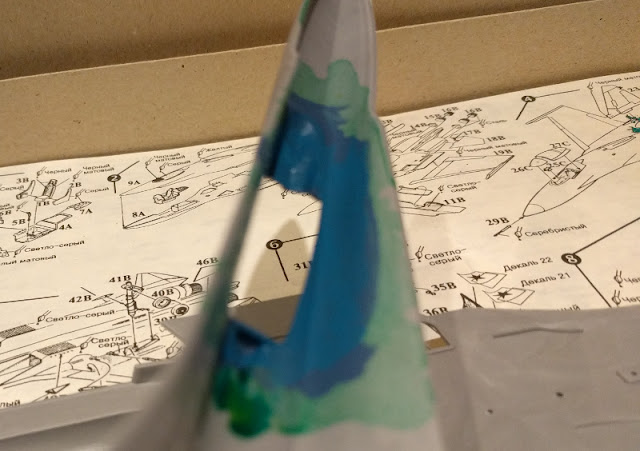Searching for the shape
Now that the cockpit was in a condition that I could live with I could get back to the business of building. As is known, the general sleek, smooth and kind of perfect shape of airplanes has been bothering me since the dawn of time itself, I haven't enjoyed the pressure these requirements put on me. That in mind I prepared for this stage with tape and pegs.Half + half
Thanks to the cockpit tub being glued in place ages ago one of the key problems was out of my way - or made worse if it was misaligned, making fixing it even more annoying than normally. The die had been cast, onwards to glory!Surprisingly the airframe halves settled together pretty nicely and without many hiccups. A couple of uglily grinning lengths I pressed together tightly and taped them shut for a while so I could do something a bit more motivating meanwhile.
Intake scoops
The intake vents, those funky lengthwise-running squarish tubes, didn't act up when I was assembling them. There was some sort of a miniramp that was added inside and while looking at them they looked like they didn't cover as much as I think they should, but what did I know about jet engines, anyway? After all, they were cleanly glued in, looked fine and that was just good enough for me.I was somehow amused by the fact that the intake things weren't glued flush against the underbelly of the Flanker but they lied on top of some small riser bits (re: photo above, left edge, arrowhead-like protrusion). My very vague memory from the MiG-29 project said that its engine air intakes were different, but it really wouldn't be the first time my memories had gotten corrupted over mere seconds, not to mention years.
Saturn AL-31F
Next up I was going for the output ends of the engines. These were built out of three parts: on the bottom there was this afterburner disc and the nozzle setup that came in two cylindrical bits.Good thing I had the patience to dry-fit the discs always before bringing out the glue, because the airframe wasn't as clean as I thought it was. The first disc fit like a glove, the second one tried to get jammed pointing a handful of degrees off. A few slashes with the x-acto knife solved that issue handily.
I really didn't count how many times I double checked that the nozzle parts were both in the correct order and set facing the right way, hopefully. At least both sets would be wrong the same way, as I really didn't know any better than to go with my "looks ok to me".
Wings
Again I got taken by surprise, in a positive way, by the kit. The main wings got installed without a hitch and they were, generally speaking, on their best behaviour. That tailplane was funny, with the extra edge piece was installed to fill the rear edge next to the exhaust bits. I dared to assume it had some important functions to take care of in the real world.Well, that was already looking like a flier, even with half of the wings missing. After installing the other half, I got to ponder what to do in which order for the painting to go as smoothly as possible. While typing this post up I was thinking along the lines of leaving the landing gear and the landing gear bay doors uninstalled so that I could paint the bays and the landing gear setup easily, avoiding my typical "how the **** am I supposed to paint this part decently anymore when it's **** full of **** already?" rants.




































